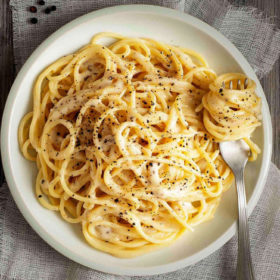
Pasta cacio e pepe
This pasta is one of the most famous and traditional Roman recipes. Made with just three ingredients but absolutely delicious! Try it!
Print
Pin
Save Recipe
Servings: 4 servings
Calories: 497kcal
Ingredients
- 320 grams (0.71 lb) spaghetti
- 1 tablespoon (1 tablespoon) whole black peppercorns 1 to 2 tablespoons
- 200 grams (2 cups) Pecorino Romano grated a little more for serving
Instructions
- Bring a large pot of salted water to a boil. Then add the pasta and cook it until it’s a little undercooked or very al dente. When it’s done, reserve 4 cups of the starchy pasta cooking water and then drain the pasta.
- As the pasta is cooking, grind the whole peppercorns with a mortar and pestle. You can also use freshly ground black pepper if you prefer.
- Put the freshly grated pecorino cheese into a medium bowl. Then stir in 1 tablespoon of lukewarm water. This helps to prevent a grainy cheese sauce.
- Toast the ground black pepper in a large pan over medium-high heat for just 30 seconds. Then add 1 ladle of pasta water and let the mixture boil for 2 minutes.
- Put the slightly undercooked pasta in the pan with the pepper water. Then add just enough of the reserved pasta water to continue cooking the spaghetti a little more. If needed, keep adding more cooking water until the noodles are creamy and perfectly al dente.
- Turn the heat off the moment the pasta is done and creamy. Now, stir in the pecorino paste and toss it together well with the spaghetti. At this point, if the pasta seems too dry just add more of the reserved cooking water.
- Serve the cacio e pepe with a bit more freshly ground black pepper and grated pecorino cheese.
Notes
The tradition of cacio e pepe pasta involves the use of spaghetti, but it is not strange to see the use of tonnarelli, rigatoni, or egg pasta. However, the egg pasta and tonnarelli are too porous and thus absorb the seasoning too much, so if you want to make excellent cacio e pepe pasta, use spaghetti.
Serving: 100g | Calories: 497kcal | Carbohydrates: 63g | Protein: 27g | Fat: 15g | Saturated Fat: 9g | Polyunsaturated Fat: 1g | Monounsaturated Fat: 4g | Cholesterol: 52mg | Sodium: 605mg | Potassium: 255mg | Fiber: 3g | Sugar: 3g | Vitamin A: 221IU | Calcium: 560mg | Iron: 2mg
Liked this recipe?Follow us NonnaBox for more!